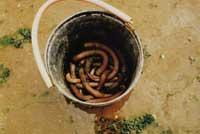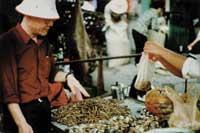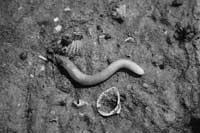Concept of sipunculids and phylum
What and how are sipunculids
Looking at the organization of the body of the sipunculids is of great importance to understand the differences with other animals of this group (there are many ways of being “worms” in Zoology...).

Its body is divided into two parts: the trunk and the retractable trunk, intercommunicated internally through the celomatic cavity, so that, in addition to the organs that are attached by the interior of the walls of the body, you can find only a celomatic spill (see figure 1). On the other hand, the size of the whole body can vary between millimeters and 30 cm.
At the end of the horn, according to the species, they have tentacles of variable appearance and at the center of these structures is the mouth. Although the front of the animal is separated by its mouth, the anus is not in the back, although it can only be thought logically: although the digestive tract reaches the rear end, it is open to the point between the tube and the trunk, with the tube of one direction rolled with the other (there are typical spires). A simple way to identify sipunculids is that the anus is located at the dorsal point of the center of the body and the digestive system has that characteristic aspect that we can observe in Figure 1. Another important morphological feature is the retardant muscles of the tube. Its function, the tube, like the fingers of a glove, is to enter the inside of the trunk.
The body walls have no signs of segmentation as discussed above. However, the epidermis may have some structures of interest (which can be of great value in the taxonomy of the group): hardened shields, sometimes calcareous, glandular papillae and keys. With the aim of solving the medium trinomial/structure/function, also in this case, although the researchers still do not know the role of the latter, they are very used in the identification of species, since it is an epidermis structure that has achieved a great diversification throughout the evolution and especially in some genera. As an example, Figure 2 shows eight different species.
Place of residence
Not only are they marine, but to know their habitat are bénticos (that is, they tend to live in the bentos or in the substratum of bottom) and this substratum, depending on the species, can be of stone or of mud or sand. On the other hand, both the tentacles and the length of the digestive system tell us something about the type of food, which are detrimental. There is also a certain diversification in this perspective of life of these worms: some filter in some way the water thanks to the tentacles and others, while making galleries to hide in the soil, devour the whole substratum, but the true classification of the food establishes the digestive system (MURINA 1984).

For reproduction different mechanisms have been described, but the most common thing is that the sexes are separated (they are dioicos) and that fertilization is associated with the gametes that each sex has left free in the water (external fertilization). The larval phase of its development, as in most animals living in the sea, is planktonic, that is, instead of living on the substratum, they swim freely (CUTLER 1994).
The sipunculids spread across the seas around the world and to all the depths of all the seas (SAIZ SALINAS 1993). Therefore, we understand the quantitative importance of these animals: the sipunculids have conquered 75% of the surface of our planet and are often the main benthic marine animals; in one case a density of 4,000 units/m2 (RICE 1983), indicator of a very high biomass has been found. But how many species make up this unknown group? Currently, only 145 species are considered valid, thanks to the review and synonization of some authors (in fact few) in the last two decades (CUTLER CUTLER and GIBBS CUTLER 1982-1994, mainly).
Within this number of species, and as often happens in Zoology and Botany, most only live in the tropics, and on our coasts biodiversity is smaller. However, in the sea of Bizkaia, more than twenty-five have collected the bibliography. Of these, only one eighth is located on the coasts of the Basque Country (SAIZ SALINAS 1993).
On the usefulness for the human being
In this beautiful coastal ecosystem, with so many different animals and groups of algae, two species of the genus Golfingia can be found by the sipunculids (G. vulgaris and G. elongata), one of the genus Phascolosoma (P. granulatum, see photo 1) and other species of cavities (Nepitzoma, Phascolion, Aspidphetón, etc. ), etc. There are two other species that prefer soft substrates: Siphonosoma arcassonense and Sipunculus nudus.
Let's call names, but... let's make a little effort to keep this last name in the head, because it is the most widespread sipunculido and among us there is another reason to be known. Those who like the cane should know that this species is very appreciated by the fish, so the grandmother used is usually another type of worm, that is, Nereis diversicolor anélido policeto, but some fishermen capture or buy sipunculido for better results (figure 2).
It may go further. This animal is a food source in some regions of the world. It is said that in some villages on the coasts of Africa and Asia sweet foods are prepared, with chicken casings or gelatin cookies and proper names (PALLAS 1774; CHIN 1947). Although the bibliographic references are ancient, today you can check this custom in the area of China and, as you can see in photo 3, the locals prepare us with the Phascolosoma arcuatum sipuncuatum sold at the fairs, a delicious food (CHEN YEH 1958).
Diversity of living beings and need for phylum
The first consequence of biological evolution is the incredible diversity of life forms faced every day by those who investigate or analyze nature. The diversity of nature leads us to talk about the diversity of species. Although the concept mentioned refers not only to the number of species but also to the relative properties of each ecosystem, etc., the number of living beings is ultimately the first cause or reason (WILSON 1992; ALTONAGA PUENTE 1995a, 1995b).
On the other hand, man's desire to order what he has before his eyes has made living beings subject to many hierarchical classifications (i.e., successive inclusive categories) (GOULD 1989). Now let us think that life on Earth is a tree that has been branching over time and we will realize that it is possible to organize that bunch of branches hierarchically (see figure 3). Therefore, the method is correct and all we need is to know what the branches are. At the ends of the branches would be the current living species that, as we move towards the base of the tree, are grouped into genera, families, order, classes, phylum and finally into kingdoms.

But all this is only a way of understanding the tree, since the only living beings that have existed over time are the species. The genera, families and other categories mentioned are only within our orderly brain. It is easier to say, a group of individuals that we now have as a species, within four million years another five species could be donated and the taxonomist of that time, will think that these five species have been born of a group that considers them as a genus, although this genus is a species from our point of view.
In that hierarchy, if phylums are just one more link, why give them so much importance? There are five kingdoms (Plantae, Animalien, Fungi, Protista and Monera) (WHITTAKER MARGULIS 1978; MARGULIS SCHWARTZ 1982), within which there are so different lives, in which the only one they have in common is that corresponding to cellular or molecular levels... Therefore, humans have to strive down to complete our classification. For example, phyplum is the basic unit of differentiation within kingdoms.
While in other taxonomic categories (species, genera, etc.) the experts of each taxon (coleoptera, jellyfish or experts of birds...) can group from bottom to top, step by step, the diversity of types of living beings, with the word phylum, we know that we must act with something else: these phylum are organizational designs of the body. And animal designs certainly take place in nature. In zoology, phyplum is a taxonomic category that has embraced a large or small number of animal species, with an original morphofacial organizational design of the body, coming from a single ancestor and totally isolated from the species of another phylum (d'HONT 1989).
What seems so simple, in practice can become a headache, for lack of fossil evidence, for similarity between two phylums of different origins (by analogies), etc. So we will come by two paths. First, looking for the number of phyplums of the animals described: BOYDEN (1973) tells us that there are 20-35 authors; secondly, it is the late "invented" category throughout history: in our sense, Haeckel first spoke of phylum in 1874.
The case of sipunculids and the concept of living disparity
Previously we mentioned cyhelminths and annelids, explaining that they were another type of worms. These are also two phylum, just like the sipunculids. Other well-known phylums are mollusk, echinoderm, arthropods (with insects, spiders and crustaceans inside) and, of course, the most cordate that has conquered our species.

Depending on the number of species, the abundance of specimens or other ecological reasons, phylums can be classified as older and smaller. That is, not all body organization designs have had the same success in evolution. In this context, the group of the sipunculids, with their 145 species, is one of those small phylum. We must not forget, however, that other designs have been much less successful and that the species associated with such designs can only be found today as fossils in nature. All this has become evident in the fossil fauna of Burgess Shale (Canada), which has become a famous rock deposit of the Cantabrian System (530 million years ago), with very precise animal designs that currently do not exist. In fact, the rarity of this fossil fauna has led researchers to describe a tenth of a new phylum (CONWAY MORRIS WHITTINGTON 1979).
While the diversity of life is represented by the number of species, the phylums corresponding to the different designs we are talking about represent the disparity of life (GOULD 1989). So, just as we use biodiversity, I think we could use the term biodisparity.
The extinction of species suggests that the history of life, of the massive eliminations and of the processes of differentiation within certain surviving stocks, is a constant. Therefore, the summary of life developed on Earth for hundreds of millions of years would be as follows: biodisparity has been leaving biodiversity to take its place slowly or through catastrophic events (GOULD 1989, 1994). If these stocks are phylum, our small group of sipunculids is the phylum that has remained alive over time, as we will see later. And here we have many questions. Have you had to suffer severe destruction within the group? Was the diversity of the sipunculids greater than the current one? We don't have fossils, so making valuations is a very difficult task.
History of phylum
If we look at the hierarchical history of the taxon in which our worms are inserted, we can see that it has been very complicated. In fact, the family, order, class and finally phylum has been considered for the last three centuries (CUTLER 1994).
As with many animals and plants, the starting point used for the description should be sought in the work of Linnaeus. However, he was not the first to describe these animals. In 1555, the French Rondelet described and drew two species. However, the names of these two species that have remained throughout history are those that Linnaeus put in disobedience to his predecessor. From there, and to this day, hundreds of species have appeared, but at present only a high percentage are synonymous. In this long way, Pallas' work is important, since in the images of the sipunculids the zootomy included drawings of what is seen after the dissection of the worms, thus inaugurating a new methodology (SAIZ SALINAS 1993).
In the systematic group, XVIII. and especially the XIX. Since the communication of all the advances and delays that have occurred in the centuries, would be very long, we only have one idea: From the work of Linnaeus to the XIX. Even the researcher De Quatrefages of the encyclopedic France of the twentieth century, the status of the sipunculids was perfected from the current point of view and progressively placed at ever higher levels. In the opinion of the latter author, the sipunculids had to form a unit with equiurids and priapulidos of another type of worms, which he called "Gephyrea". After a hundred years of controversy, in 1959, Hyman was the woman who abandoned this artificial unit, conquering the phylum grade for the group of the sipunculids and the name "Sipunculida". After a few years, the phylum underwent the last name change: it was given the current "Sipuncula".
Place and evolution of phyluma

The place within the animal classification of the sipunculids is related to the formation of invertebrates and worms. But it is not enough. To express things accurately, we have to add something else: a) they are celestial metazoas: among the cellular layers that have a pluricellular organization and that appear in the embryonic development are animals with cavities or celomes; b) they are protostomates: although most of the known animals are celestial, there are two forms or ways of being celestial (that is, depending on the development): the model of the segmented protostomates are adocumented.
These characteristics, which a priori do not clarify much the problem, have placed the group in a place (or rather, area) of the evolutionary labyrinth. Among the daring to enter this labyrinth, some authors have seen and described the similarities of the sipunculids with annelids, equiurids and other groups... Taking as an example a previous tree of life, the RICE (1985) states that the sipunculids will be an asterisk that separated from the mollusco/anélido line, being two phylum that claim to be related to the Moscow and the annelids. Unfortunately, the valuable information that a few fossils can offer remains science-fiction.
When did all this happen? Phylum's origin lies in the Cambrian system started 570 million years ago. If it were possible to explain the lack of fossils throughout geological history, not only because of the characteristic of soft bodies, but also because of their scarcity in ecosystems… how would we understand that these worms had survived so far? Although the number of species is low, the sipunculido has always been sufficient. Apparently, Sipuncula is an ancient taxon with an unknown history of branching and destruction. This taxon at first was going to undergo the changes quickly; then it would maintain the same aspect for a long time and its companions would have the opportunity to continue living in the ecological corners that were then covered (see photo 4) (CUTLER 1994).
There is another reason or hypothesis of how this old group has managed not to lose under the force of destruction. Only the inhabitants of some eastern localities have introduced the sipunculids in their diet. What if Western Chinese restaurants started serving as a delicious food?





